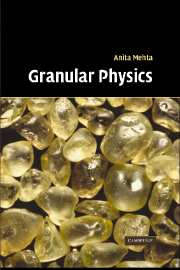Book contents
- Frontmatter
- Contents
- Preface
- 1 Introduction
- 2 Computer simulation approaches – an overview
- 3 Structure of vibrated powders – numerical results
- 4 Collective structures in sand – the phenomenon of bridging
- 5 On angles of repose: bistability and collapse
- 6 Compaction of disordered grains in the jamming limit: sand on random graphs
- 7 Shaking a box of sand I – a simple lattice model
- 8 Shaking a box of sand II – at the jamming limit, when shape matters!
- 9 Avalanches with reorganising grains
- 10 From earthquakes to sandpiles – stick–slip motion
- 11 Coupled continuum equations: the dynamics of sandpile surfaces
- 12 Theory of rapid granular flows
- 13 The thermodynamics of granular materials
- 14 Static properties of granular materials
- References
- Index
- Plate section
2 - Computer simulation approaches – an overview
Published online by Cambridge University Press: 06 October 2009
- Frontmatter
- Contents
- Preface
- 1 Introduction
- 2 Computer simulation approaches – an overview
- 3 Structure of vibrated powders – numerical results
- 4 Collective structures in sand – the phenomenon of bridging
- 5 On angles of repose: bistability and collapse
- 6 Compaction of disordered grains in the jamming limit: sand on random graphs
- 7 Shaking a box of sand I – a simple lattice model
- 8 Shaking a box of sand II – at the jamming limit, when shape matters!
- 9 Avalanches with reorganising grains
- 10 From earthquakes to sandpiles – stick–slip motion
- 11 Coupled continuum equations: the dynamics of sandpile surfaces
- 12 Theory of rapid granular flows
- 13 The thermodynamics of granular materials
- 14 Static properties of granular materials
- References
- Index
- Plate section
Summary
Sand has many avatars – it can behave as a solid, liquid or gas, depending on external circumstances. This multiple identity is one of several reasons why the computer simulation of dry granular materials is difficult. Sand in the solid-like state responds to external stimuli on a very different timescale to sand in its liquidlike avatar – in contrast to most efficient computer simulation methods, which are typically tuned to one particular timescale such as a collision or relaxation time. Other features of sand which are difficult to simulate efficiently include complex, dissipative interparticle and particle–wall interactions, typically irregular grain shapes and strong hysteretic effects. Furthermore, the athermal nature of sand means that grains do not randomly sample all possible states ergodically – as a result, appropriate statistical averages can only be obtained by repeated (computationally demanding) simulations of a granular system.
For normal dry powders, interstitial fluid plays only a minor role – apart from exceptional cases when, say, there are small liquid pools at particle contacts which could seriously alter the pairwise nature of grain interactions. This is a clear distinction between granular systems and dense suspensions – for the former, interparticle interactions are restricted to short-ranged contact forces. In practice, the methods developed for granular simulations are quite similar to classical methods used to simulate simple liquids.
- Type
- Chapter
- Information
- Granular Physics , pp. 18 - 26Publisher: Cambridge University PressPrint publication year: 2007



